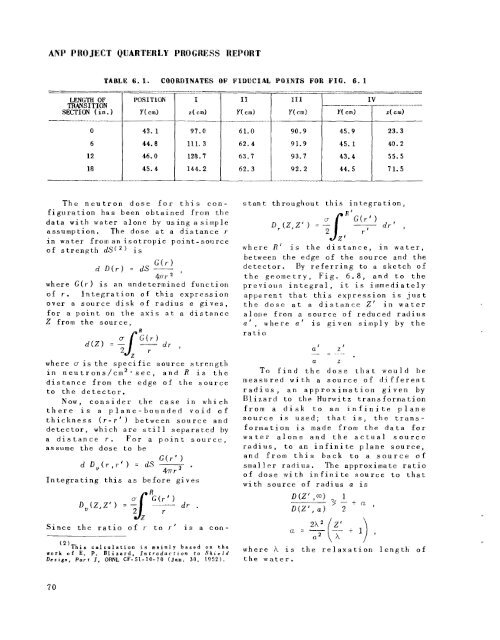the Molten Salt Energy Technologies Web Site
the Molten Salt Energy Technologies Web Site
the Molten Salt Energy Technologies Web Site
You also want an ePaper? Increase the reach of your titles
YUMPU automatically turns print PDFs into web optimized ePapers that Google loves.
ANP PROJECT QUARTERLY PROGRESS REPORT<br />
-<br />
__l__l__<br />
.___. ..._____I ___<br />
.- ---.-I l_l_ .........<br />
LFWi'IX OF<br />
TRANSITION<br />
SECTION (in.)<br />
.<br />
POSITlON<br />
Y( cm)<br />
I<br />
z( cm)<br />
I1<br />
Y( cm)<br />
111<br />
Y( cm) Y( c d<br />
IV<br />
z( cm)<br />
___<br />
0<br />
6<br />
12<br />
18<br />
The neutron dose €or this con-<br />
figuration has been obtained from <strong>the</strong><br />
data with water alone by using asiinple<br />
assumption. The dose at a distance r<br />
in water frorn an isotropic point-source<br />
of strength dS(') is<br />
-- . ____ ..........<br />
G(r)<br />
d D(r) = dS - ,<br />
&rr<br />
where G(r) is an undetermined functiori<br />
of r. Integration of this expression<br />
over a source disk of radius a gives,<br />
for a point on <strong>the</strong> axis at a distance<br />
Z from <strong>the</strong> source,<br />
where w is <strong>the</strong> specific source st,rength<br />
in neutrons/cm2-sec, and R is <strong>the</strong><br />
distance from <strong>the</strong> edge of <strong>the</strong> source<br />
to <strong>the</strong> detector,<br />
Now, consider <strong>the</strong> case in which<br />
<strong>the</strong>re is a plane-bounded void of<br />
thickness (r-r' between source and<br />
detector, which are still separated by<br />
a distance r. For a point source,<br />
assume <strong>the</strong> dose to be<br />
Integrating this as before gives<br />
Since <strong>the</strong> ratio of r to r' is a con-<br />
(2)This calculation i s mainly based on <strong>the</strong><br />
work of E. P. Blizard, Zntroductron to Shreld<br />
Desrgn, Part Z, ORNL CF-51-10-70 (Jan. 30, 1352).<br />
70<br />
43. 1 97.0 61.0 90.9 45.9 23.3<br />
44.8 111.3 62.4 91.9 45.1 40.2<br />
46.0 128 7 63.7 93.7 43.4 55.5<br />
45.4 144.2 62. 3 92. 2 44.5 71.5<br />
- .<br />
stant throughout this integration,<br />
.-I__<br />
--.-._.I<br />
where A' is <strong>the</strong> distance, in water,<br />
between <strong>the</strong> edge of <strong>the</strong> source and <strong>the</strong><br />
detector. By referring to a sketch of<br />
<strong>the</strong> geometry, Fig. 6.8, and to <strong>the</strong><br />
previous integral, it is immediately<br />
apparent that this expression is just<br />
<strong>the</strong> dose at a distance 2' in water<br />
alone from a source of reduced radius<br />
a', where a' is given simply by <strong>the</strong><br />
ratio<br />
_I a' - Z' ._<br />
a Z<br />
To find <strong>the</strong> dose that would be<br />
measured with a source of different<br />
radius, an approximation given by<br />
Blizard to <strong>the</strong> Hurwitz transformation<br />
from a disk to ari infinite plane<br />
source is used; that is, <strong>the</strong> trans-<br />
formation is made from <strong>the</strong> data for<br />
water alone and <strong>the</strong> actual source<br />
radius, to an infinite plane source,<br />
and from this back to a source of<br />
smaller radius. The approximate ratio<br />
of dose with infinite source to that<br />
with source of radius a is<br />
D(Z',m) ~ 1<br />
>--fa,<br />
8(Z',a) 2<br />
where h is <strong>the</strong> relaxation length of<br />
<strong>the</strong> water.



![Review of Molten Salt Reactor Physics Calculations [Disc 2]](https://img.yumpu.com/21979492/1/190x247/review-of-molten-salt-reactor-physics-calculations-disc-2.jpg?quality=85)












